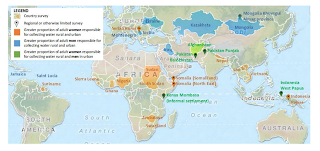Women and water collection rural vs urban areas

I recently came across a report highlighting that in many developing countries, it is the case that the proportion of women involved in water collection is close to being equal to men in both rural and urban areas (Geere, 2017) as shown in figure 1. Interestingly however, this trend is less significant in Sub-Saharan Africa (with the exception of Mombosa and Kenya) where in both rural and urban areas, women proportionately are the main bearers of water. With this finding, I came across an interesting case study in Ghana, which will provide an insight into the influence of cultural norms tied in with women in African societies and the influence of socio-economic status affecting the roles of women in water collection in both rural and urban areas. Figure 1: Responsibilities of water collection in rural and urban areas In Kumasi city, the 2 nd largest metropolitan areas in Ghana, there is an increasing need for water to meet the needs for increa